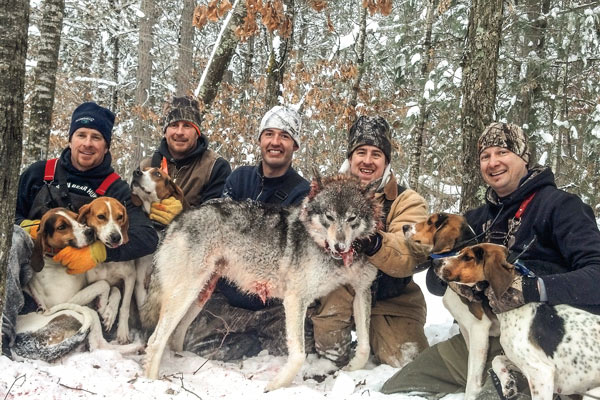March 02, 2015
By David Zeug
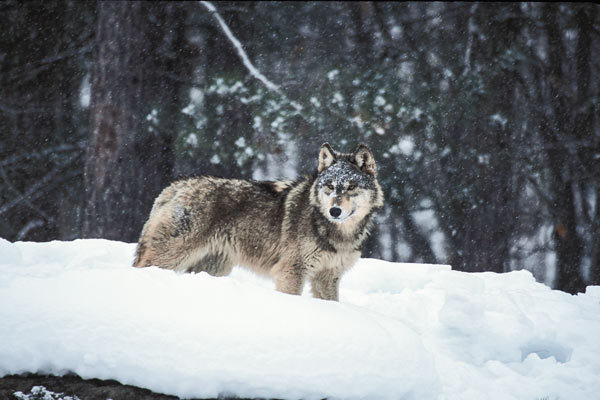 Teddy Roosevelt did it. So did General George Armstrong Custer. Now over 100 years later, a few Wisconsin hunters can say they've hunted wolves using dogs too.
Teddy Roosevelt did it. So did General George Armstrong Custer. Now over 100 years later, a few Wisconsin hunters can say they've hunted wolves using dogs too.
The hunt was approved by the Wisconsin legislature in the spring of 2012, although a Dane County judge in Madison, the state's capital, soon issued an injunction stopping it. In January of 2013 the injunction was lifted however, and 10 months later on Dec. 2, 2013 hound hunters were allowed to drop their dogs on wolf tracks. Wisconsin is the only state in the Union that allows the hunting of wolves with dogs.
Prior to Dec. 2, the wolf hunting and trapping season had been open in Wisconsin, but it wasn't legal to use dogs. However, by that date the quotas in five of the six wolf hunting zones had been met through trapping and other forms of hunting, stopping any additional wolf harvest in those zones. Zone 3 though, in the remote northwest corner of the state had a total quota of 71 wolves that hadn't yet been reached, making it legal to hunt with hounds.
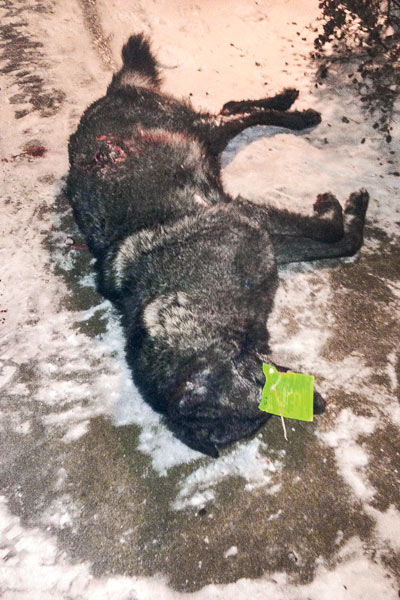 The hunt ended on Dec. 23 when the quota was reached with most of the wolves having been taken with the use of dogs. The state had a total quota of 251 wolves from an overwinter population between 809 to 834.
The hunt ended on Dec. 23 when the quota was reached with most of the wolves having been taken with the use of dogs. The state had a total quota of 251 wolves from an overwinter population between 809 to 834.
Advertisement
Although this hunt was controversial among both anti-hunters and some active hunters who compared it to dog fighting, most hound hunters disagreed. Those opposed to the hunt felt wolves would kill or injure dogs as has been documented in the past.
Wisconsin law reimbursed hound hunters who had dogs killed or injured by wolves while hunting bears, similar to how it reimbursed farmers who lost other types of domestic animals to wolves. During the wolf hunt though, the law was clear in stating hunters would not be reimbursed if they lost dogs while intentionally hunting wolves.
Others feared packs of hounds may actually kill the wolves, which has happened before. During wolf hunts in Roosevelt's time, big, long-legged wolfhounds and staghounds were used to hunt wolves in more open western states. In those times and places it had been documented dogs did run down and kill wolves.
Advertisement
The Hound Crew
Jay and Jake Johnson are brothers who have a long history of hunting coyotes, bobcats and bears with their hounds. Surprisingly, both drew wolf tags last year and since they didn't share the concerns others did and hunted in Zone 3, they intended to pursue wolves as soon as they legally could. In the absence of any modern wolf hunts to draw conclusions from, there was a lot of speculation from both sides, but nothing else. However, by the end of the December season, both hunters were able to shed some light on the question.
Jay, Jake and their friends have a reputation of working hard and playing hard. That also includes taking their hunting and the care of their dogs seriously. They simply wouldn't put their dogs in a situation where there's a strong possibility they could be killed or injured. As Jay says, "there are risks when my kids play football too, but it's a risk I accept."
The brothers use trailing hounds when hunting and planned to use the same dogs they use on bears and coyotes on the wolves. Experienced hunters, they knew the December hunt wasn't the time to worry about wolves injuring their hounds.
"Our biggest concern over having a bad encounter with a wolf isn't during the December hunting season, it's during the bear season (bear dog training season opens on July 1 and hunting season starts in early September), especially if we get near a wolf rendezvous site when hunting bears," said Jay.
Rendezvous sites are locations where pups are left for long periods of time while the adults are hunting. These sites are used from mid-June until early fall, long before the wolf pups are strong enough to keep up with the pack. Understandably, wolves are very protective of their young during this time of the year.
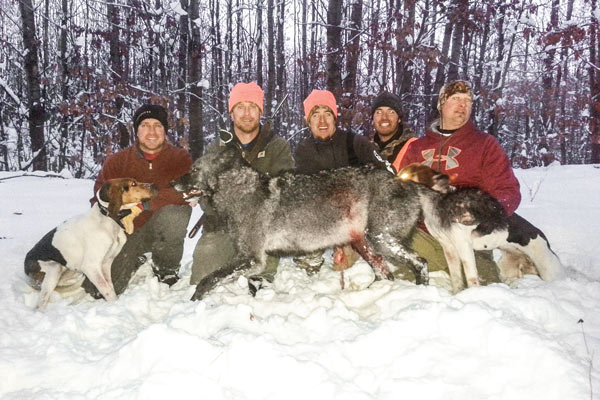 "We're not going to release our dogs on the tracks of multiple wolves, we look for one animal. Single wolves aren't as bold as a pack of wolves will be. When we released our dogs, which are basically athletes doing what they've been bred to do, we expected them to bay up the wolf just like they do with a bear that doesn't tree," Jay continued.
"We're not going to release our dogs on the tracks of multiple wolves, we look for one animal. Single wolves aren't as bold as a pack of wolves will be. When we released our dogs, which are basically athletes doing what they've been bred to do, we expected them to bay up the wolf just like they do with a bear that doesn't tree," Jay continued.
Baying up is a term used by hound hunters when an animal holds its ground as the dogs circle it. "That's exactly what's happened this year with the wolves. None of our dogs were hurt during the chase nor was the wolf bit by the dogs before the animal was killed," Jake added. "In fact, the dogs stayed further away from the wolf than they did when they've had a bear bayed up."
The Johnson boys traditionally use Walker hounds. "These aren't fighting dogs, they're family-raised pets. The smaller dogs in the 40- to 50-pound range were the ones that caught and bayed up the wolves," said Jake.
Walkers are fast, agile and vocal with a distinctive bay that allows the hunters to identify their hounds from a distance. They're also known for their intelligence and even-tempered nature. And while they enjoy interacting with humans, they're also "track hungry," which means they're tireless and intense when following a scent.
No more than six dogs can legally be used at one time when hunting with dogs in Wisconsin, although these hunters never used that many. "We only used two or three dogs at a time on the wolf," Jake added. Jay and Jake each harvested wolves early in this inaugural Wisconsin hunt, and 35 were taken with the aid of dogs before the season ended on Dec. 23.
Wolf Tracks
Heavy snowfalls came early in northwest Wisconsin last December and at this latitude, there isn't much daylight this time of the year. This meant wolf hunters had to be on the trail well before daybreak, driving back roads and logging trails looking for fresh wolf sign.
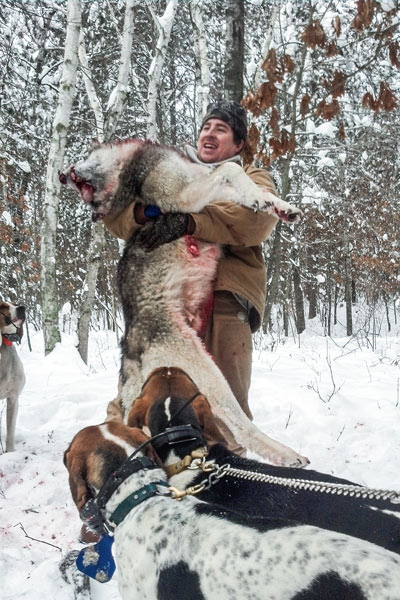 "We found wolf tracks in the 15 to 20 inches of new snow that had fallen overnight about 10 a.m., which marked the beginning of the most physically demanding hunt I've ever been on," said Jay. "After we cut the tracks, we followed them on foot without dogs through the snow for what seemed like miles until we found a buck fawn they killed.
"We found wolf tracks in the 15 to 20 inches of new snow that had fallen overnight about 10 a.m., which marked the beginning of the most physically demanding hunt I've ever been on," said Jay. "After we cut the tracks, we followed them on foot without dogs through the snow for what seemed like miles until we found a buck fawn they killed.
"We figured they would be bedded down close by, so we continued trailing them until we jumped one up. That was the first time we dropped a couple dogs on the track," Jay said. In reality, it was the first time anyone had dropped dogs on a wolf track anywhere in the U.S. for over a century.
Although it was still only late morning, the chase continued until deep into the early winter afternoon, covering four or five miles of public forest. "A couple dogs seemed to work better because the track is less confusing then and they're able to stay on it. By now it was getting late in the day and I was worried we'd run out of daylight.
I've hunted this area before and knew there was a funnel of sorts up ahead of the wolf and dogs, so I headed up toward it. As I got closer, I saw the wolf coming and was surprised to see it was a big black one. There was only one dog following it now, but I could hear the others coming. They kept their distance from each other, neither wanting to engage in any fighting.
With the other dogs coming, the wolf finally bayed up and I managed to get within 40 yards of him and took the shot with my .243," said Jay. "He went right down on the spot. I've spent my whole life hunting, but this was one of the most memorable hunts of my life."
Several days later, the brothers and some friends were back in the same area. This time it was Jake's turn, which was only fitting since he passed up an iffy shot on the wolf Jay shot earlier. "I found the single wolf track around 7 a.m., just as it was getting light. It was near the same fawn carcass we'd seen before.
"Since it was so early, I decided to wait for the rest of the crew to arrive. When they got there about an hour later, we dropped the same three dogs on the track we used before and they cold tracked the wolf for nearly a mile before jumping it," said Jake.
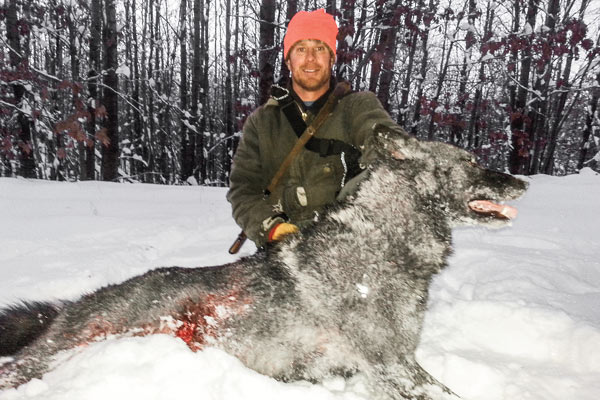
"With the cold, the dogs had some trouble with the track, but eventually sorted it out. When it crossed a road, we dropped some fresh dogs on the trail. I managed to get close to them once and saw the wolf crossing the ice on a small, marshy lake. With the dogs not far behind it, I didn't feel I had a good shot, so I didn't take it. Eventually the wolf went into some low pines and bayed up while I snuck toward him.
"I could make him out behind some pine boughs with the dogs about five yards away. Even though I was within 10 yards of him, with the heavy cover and dogs, I didn't have the shot I wanted. Then he saw me and began running again ahead of the dogs. After another half-mile or more, I managed to get in front of him and finally saw him angling toward me.
"When he was about 50 yards away, he gave me the shot I wanted and I dropped him with my .223. He was a magnificent animal and it's a hunt I'll never forget," Jake said, adding that over the course of two hunts he saw the wolf six or seven times and the dogs always kept their distance. "Respect was given by both wolf and dog."
Due to new court challenges that have been filed against this unique hunt, the final chapter about wolf hunting with the aid of dogs has yet to be written. Time will tell if outdoorsmen like Jake and Jay will be able to continue to follow their dogs through Wisconsin's woods or not.
But there's one thing the brothers want people to know. "We don't hate wolves like some do, but we realize their population needs to be controlled like any other wild animal and we'd like the opportunity to do it with the use of our dogs."
